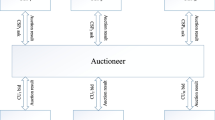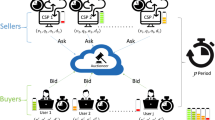Abstract
Cloud computing is a business model where having users and providers are competing to sell and buy services. Due to diverse software applications and dynamic cloud market, customers’ requirements are ever changing. Dynamic auction-based resource allocation models, namely: combinatorial double auction resource allocation (CDARA) model attracted the researchers’ attention. In existing work services are allocated to users based on less price, which may lead to service-level agreement (SLA) violation and increase user’s dissatisfaction in the cloud marketplace. Decision on single attribute price may create genuine and ungenuine providers issue, as the providers will try to provide low-quality services. To solve these issues, we proposed adaptive market-oriented combinatorial double auction resource allocation (AMO-CDARA) model that allocates services to users based on multiple parameters such as less price, QoS, and providers ranking. In the proposed model, bids are received by auctioneer from multiple providers and users. Auctioneer calculates users and providers bid densities and allocates services to the most efficient users from most efficient providers according to their required request. After successful running of tasks, the auctioneer asks for feedback of the used services from users and calculates the final ranking of providers for future auctions. The simulation results show that the proposed model guaranteed SLA violation up to 99% due to twice punishment penalty and ranking of providers. The guaranteed QoS users/brokers will provide extra payment for that, and the extra payment will be from 1 to 10% of the total price, according to the final price. Furthermore, we solved the bidder drop problem up to 10% by increasing service price by adding QoS price.
















Similar content being viewed by others
Change history
21 July 2021
A Correction to this paper has been published: https://doi.org/10.1007/s11227-021-03987-y
References
Mell, P. and Grance, T., 2011. The NIST definition of cloud computing.
Batista BG, Estrella JC, Ferreira CHG, Leite Filho DM, Nakamura LHV, Reiff-Marganiec S, Santana MJ, Santana RHC (2015) Performance evaluation of resource management in cloud computing environments. PloS one 10(11):0141914
Aceto G, Botta A, De Donato W, Pescapè A (2013) Cloud monitoring: a survey. Comput Netw 57(9):2093–2115
Samimi, P. and Patel, A., 2011 Review of pricing models for grid & cloud computing. In 2011 IEEE Symposium on Computers & Informatics (pp. 634–639). IEEE
Santhiya H, Karthikeyan P (2013) Survey on auction-based scheduling in grid and cloud environment. Int J Comput Appl 62(8):6–9
Izakian H, Ladani BT, Zamanifar K, Abraham A and Snasel V (2009) A continuous double auction method for resource allocation in computational grids. In 2009 IEEE Symposium on Computational Intelligence in Scheduling (pp. 29–35). IEEE
Tan Z and Gurd JR (2007) Market-based grid resource allocation using a stable continuous double auction. In 2007 8th IEEE/ACM International Conference on Grid Computing (pp. 283–290). IEEE
Zaman S, Grosu D (2013) Combinatorial auction-based allocation of virtual machine instances in clouds. J Parallel Distrib Comput 73(4):495–508
Sandholm T (2002) Algorithm for optimal winner determination in combinatorial auctions. Artif Intell 135(1–2):1–54
Zhang J, Xie N, Zhang X, Yue K, Li W, Kumar D (2018) Machine learning based resource allocation of cloud computing in auction. Comput Mater Continua 56(1):123–135
Noor A, Umer A, Umar AI, Ahmad Z, Khan M (2018) Usability evaluation of brain-computer interaction (BCI), based game for normal users. Int J Comput Sci Netw Secur 18(6):168–175
Ahmad Z, Nazir B, Umer A (2021) A fault-tolerant workflow management system with Quality-of-Service-aware scheduling for scientific workflows in cloud computing. Int J Commun Syst 34(1):4649
Adnan M, Iqbal J, Waheed A, Amin NU, Zareei M, Goudarzi S, Umer A (2021) On the design of efficient hierarchic architecture for software defined vehicular networks. Sensors 21(4):1400
Samimi P, Teimouri Y, Mukhtar M (2016) A combinatorial double auction resource allocation model in cloud computing. Inf Sci 357:201–216
Li H, Liu J and Tang G (2011) A pricing algorithm for cloud computing resources. In 2011 International Conference on Network Computing and Information Security (Vol. 1, pp. 69–73). IEEE
Sharma B, Thulasiram RK, Thulasiraman P, Garg SK and Buyya R (2012) Pricing cloud compute commodities: A novel financial economic model. In 2012 12th IEEE/ACM International Symposium on Cluster, Cloud and Grid Computing (ccgrid 2012) (pp. 451–457). IEEE
Wang W, Zhang P, Lan T and Aggarwal V (2012) Datacenter net profit optimization with individual job deadlines. In Proc. Conference on Inform. Sciences and Systems.
Mihailescu M and Teo YM (2010) Dynamic resource pricing on federated clouds. In 2010 10th IEEE/ACM International Conference on Cluster, Cloud and Grid Computing (pp. 513–517). IEEE
Toosi AN, Calheiros RN, Buyya R (2014) Interconnected cloud computing environments: challenges, taxonomy, and survey. ACM Comput Surv (CSUR) 47(1):1–47
Wei W, Fan X, Song H, Fan X, Yang J (2016) Imperfect information dynamic stackelberg game-based resource allocation using hidden Markov for cloud computing. IEEE Trans Serv Comput 11(1):78–89
Di Modica G, Tomarchio O (2015) Matching the business perspectives of providers and customers in future cloud markets. Clust Comput 18(1):457–475
Singh S, Chana I (2015) Q-aware: quality of service-based cloud resource provisioning. Comput Electr Eng 47:138–160
Zhang X, Li B, Zhu J (2015) A combinatorial auction-based collaborative cloud services platform. Tsinghua Sci Technol 20(1):50–61
Ghobaei-Arani M, Rahmanian AA, Aslanpour MS, Dashti SE (2018) CSA-WSC: cuckoo search algorithm for web service composition in cloud environments. Soft Comput 22(24):8353–8378
Dibaj SR, Miri A, Mostafavi S (2020) A cloud priority-based dynamic online double auction mechanism (PB-DODAM). J Cloud Comput 9(1):1–26
Baranwal G, Vidyarthi DP (2015) A fair multi-attribute combinatorial double auction model for resource allocation in cloud computing. J Syst Softw 108:60–76
Li, Q., Huang, C., Bao, H., Fu, B. and Jia, X., 2019, July. A game-based combinatorial double auction model for cloud resource allocation. In 2019 28th International Conference on Computer Communication and Networks (ICCCN) (pp. 1–8). IEEE
Singhal R and Singhal A (2019) A combinatorial fair economical double auction resource allocation model. In International Conference on Advances in Computing and Data Sciences (pp. 272–281). Springer, Singapore.
Ghobaei-Arani M, Souri A, Baker T, Hussien A (2019) ControCity: an autonomous approach for controlling elasticity using buffer Management in cloud computing environment. IEEE Access 7:106912–106924
Ghobaei-Arani M, Jabbehdari S, Pourmina MA (2016) An autonomic approach for resource provisioning of cloud services. Clust Comput 19(3):1017–1036
Singhal R and Singhal A (2019) A combinatorial economical double auction resource allocation model (CEDARA). In 2019 International Conference on Machine Learning, Big Data, Cloud and Parallel Computing (COMITCon) (pp. 497–502). IEEE
Lu Y, Zheng X, Li L, Xu LD (2020) Pricing the cloud: a QoS-based auction approach. Enterprise Inform Syst 14(3):334–351
Garg SK, Versteeg S, Buyya R (2013) A framework for ranking of cloud computing services. Futur Gener Comput Syst 29(4):1012–1023
Davy A, Botvich D and Jennings B, (2007) On the use of accounting data for QoS-aware IP network planning. In International Teletraffic Congress (pp. 348–360). Springer, Berlin, Heidelberg.
Calheiros RN, Ranjan R, De Rose CA and Buyya R (2009) Cloudsim: A novel framework for modeling and simulation of cloud computing infrastructures and services. arXiv preprint ar@Xiv:0903.2525.
Song H, Zhu J and Jiang Y (2020) On truthful auction mechanism for cloud resources allocation and consumption shifting with different time slots. Concurrency and Computation: Practice and Experience, 6122. https://doi.org/10.1002/cpe.6122
Murillo J, López B, Muñoz V, Busquets D (2012) Fairness in recurrent auctions with competing markets and supply fluctuations. Comput Intell 28(1):24–50
Sun W, Liu J, Yue Y, Zhang H (2018) Double auction-based resource allocation for mobile edge computing in industrial internet of things. IEEE Trans Industr Inf 14(10):4692–4701
Baranwal G, Vidyarthi DP (2016) A truthful and fair multi-attribute combinatorial reverse auction for resource procurement in cloud computing. IEEE Trans Serv Comput 12(6):851–864
Author information
Authors and Affiliations
Corresponding author
Additional information
Publisher's Note
Springer Nature remains neutral with regard to jurisdictional claims in published maps and institutional affiliations.
The original online version of this article was revised:
Supplementary Information
Below is the link to the electronic supplementary material.
Rights and permissions
About this article
Cite this article
Umer, A., Nazir, B. & Ahmad, Z. Adaptive market-oriented combinatorial double auction resource allocation model in cloud computing. J Supercomput 78, 1244–1286 (2022). https://doi.org/10.1007/s11227-021-03918-x
Accepted:
Published:
Issue Date:
DOI: https://doi.org/10.1007/s11227-021-03918-x




